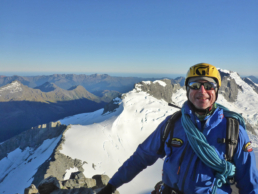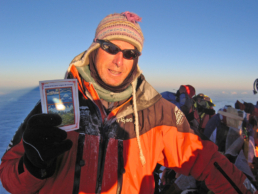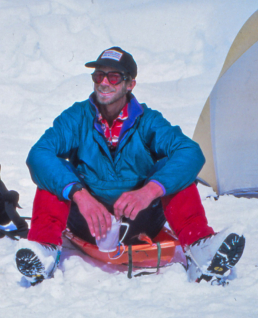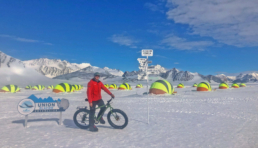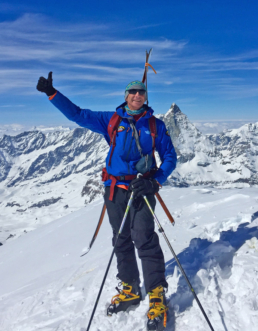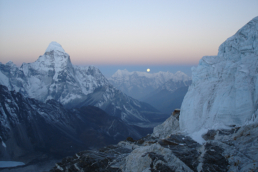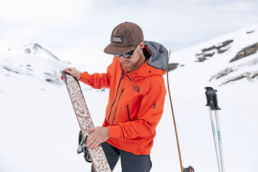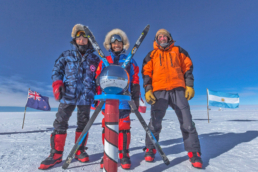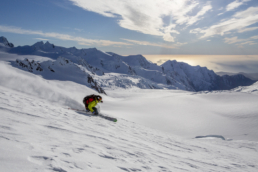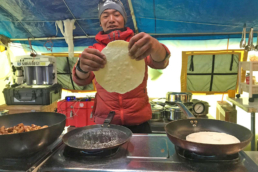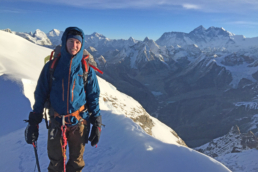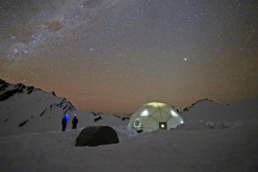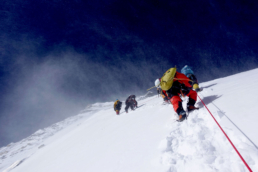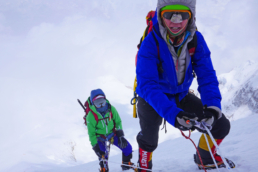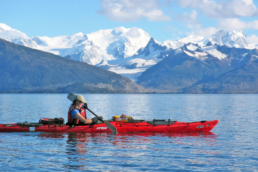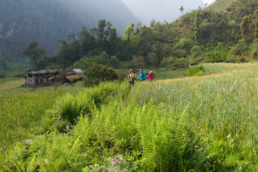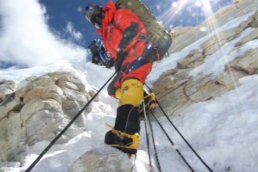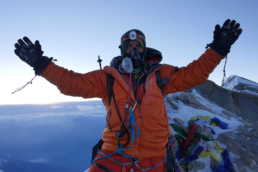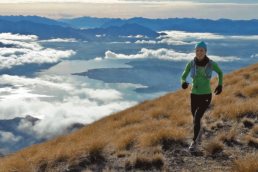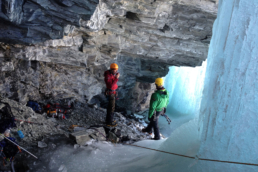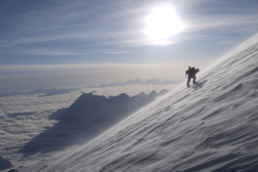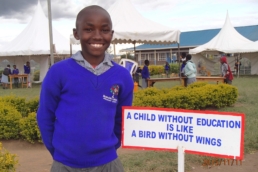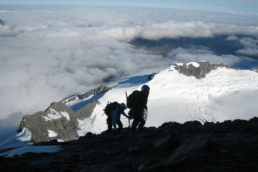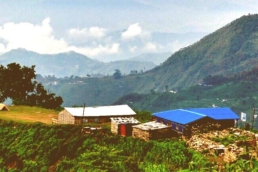The Call of the Mountains
AC Guide Mike Roberts has had 30 years’ experience guiding some of the highest and remotest peaks across the globe, including an astounding nine summits of Mount Everest. We caught up with Mike in between expeditions for some reflections on how he entered the industry in his native New Zealand and the incredible places his career has taken him since.
How were you first introduced to climbing?
I was first introduced to mountaineering through the Napier Tramping Club when aged seventeen. I received basic instruction in the use of crampons and ice axe on an exposed ridge in the Ruahine Ranges; I was hooked from the start. My first forays into mountaineering were on the Central North Island volcanoes of Ruapehu and Ngauruhoe. While most of my tramping mates were inclined to stay in the valleys during winter when snow blanketed the high terrain, I was drawn to the tops. I was as excited as I was terrified at the prospect of trying bigger climbs. It was not until a couple of years later that I was introduced to rock climbing by a friend at Castle Rock in the Port Hills. I’ll never forget the exhilaration of climbing Hangman and Flying Buttress for the first time; classic climbs that no longer exist since the 2011 Christchurch earthquake.
After leaving school, I worked for the New Zealand National Parks Service and studied Parks and Recreation at Lincoln University. I was fortunate to meet several strong mountaineers who became mentors and enabled me to start climbing more seriously.
What made you want to become a mountain guide?
In my mid-twenties I lived for climbing and was fortunate to get my dream job working as a mountaineer (or climbing ranger in today’s vernacular) at Aoraki Mount Cook National Park. It was fantastic to be surrounded by climbers and given so many opportunities to alpine climb. Progressively I gained skills, climbing harder routes and rock climbing at every opportunity. The professional instruction I received in search and rescue, first aid, and avalanche forecasting opened doors. Several of my peers began guiding and I decided to follow suit. As much as I enjoyed my seven years working in different national parks, I was restless for adventure, yearned for change and decided to try mountain guiding.
How did you find the process of qualifying as a mountain guide?
There’s no doubt that the pathway to becoming a mountain guide is demanding. For me, mountain guiding felt like a calling and I was passionately driven to do everything it took. I was fortunate to be in my prime and to have done a lot of climbing. Like many NZ mountain guides, the professional level training I received through working as a mountaineer at Mount Cook National Park acted as a great stepping-stone. My desire to recreationally climb and ski strongly aligned with the guiding career path. I would take long rock climbing holidays and grew to love the rock climbing found at Australia’s Mount Arapiles. In order to increase my skiing ability and gain my Level 2 Avalanche Qualification, I began working as a ski patroller, a career allied to guiding that I enjoyed. As an aspirant guide I would voluntarily assist qualified guides to gain experience. All told, it took me four years to become IFMGA qualified, but that was just the start.
How has the profession evolved over your 30 years of guiding experience?
To become IFMGA qualified you must be skilled in rock, ice, alpine and ski. Most folks have a discipline they are strong in and one they must work at. In my generation most aspirants were primarily climbers and, like me, had to work hard to get their skiing up to par. Winter courses were based on using skis for alpine climbing access. I was part of the transition where the emphasis in winter shifted towards providing quality ski touring. Interestingly, I commonly see the reverse these days, where folks are strong skiers but have little alpine climbing experience.
Over time the career pathway has become more defined, broken into smaller steps, more sophisticated and offers better instruction. I think it’s also true that folks do not enter the profession with as high a mileage in the alpine environment.
What’s your favourite aspect of the job?
I love being in the mountains, polar environments and on crags—these are my happy places. I don’t necessarily need a technical focus, which is why I’ve enjoyed so many seasons working with scientists in remote parts of Antarctica. In general, when I was young, I was driven more towards technical climbing. As I’ve grown older, I enjoy the journey, travel and culture equally as much. I’ve always enjoyed teaching and helping others meet their goals. I’m privileged to meet a lot of fascinating and fantastic people.
What is your career highlight?
I’ve been fortunate to have many career highlights. I’ll never forget my first clients, crossing the Copland Pass; the beginning of a life-long career. Guiding a traverse of Denali during my first year as an aspirant guide was particularly memorable. Finding myself in remote mountainous regions of Antarctica where only a handful of people have been. Learning to enjoy powder skiing and the fun of heliskiing. Guiding a first ascent from a yacht on the Antarctic Peninsula. Skiing from the summit of Muztagh Ata in the Chinese Pamirs. Standing on top of Gasherbrum 2 in Pakistan. The first time I reached the summit of Everest. Guiding European classics like the Matterhorn. Completing consecutive ascents of Everest and Lhotse.
What is the biggest misconception you hear/have about being a guide?
Embarking on a guiding career opens a wider array of work opportunities than you may realize. I have enjoyed several seasons ski patrolling, have dabbled in outdoor education, worked in avalanche education, guided multi-pitch rock, have completed many high-altitude expeditions around the globe, worked on film safety and have done numerous seasons working in Antarctica with scientists. Keep it interesting by working in different disciplines, cultures and terrain—travel.
Is there anything you know now that you’d wish you’d known in your early career?
It’s OK to be belayed by your client on steep terrain—do what’s safe! When I began guiding there was a much more macho attitude; for example, being belayed on the summit rocks of Aoraki Mount Cook was a sign of weakness. Guides can be very opinionated—there’s never just one way to do things—be open minded and expose yourself to different techniques and approaches. Be wary of techniques and practices that are nothing more than ‘pet theories’ without research to back them; be objective and think things through.
Is there anything still burning on your mountaineering bucket list?
I no longer have the burning ambitions of my youth where there was always a next objective and a long list of must do’s. I’d like to do some journeys on skis, spend more time on rock and return to my roots, appreciating more remote locations and transalpine trips. I’ve more climbs left in me but I’m less choosey about what they are.
What advice can you offer someone looking to go down the same pathway?
Get started while you’re young, in your prime, and highly motivated – it’s easier that way. As soon as you get work and family commitments it’s much harder to devote the time needed and to maintain a high technical skill level. Try and align your recreational pursuits with increasing your skills base. This way it won’t feel like you’re always training for your next guides course, but rather you’re having a holiday, pursuing your passion and increasing your skills at the same time. You need to pay your dues, spend a lot of time in the different disciplines—if you try and short-cut the process, you’ll put yourself under undue pressure when being assessed.
If you’re interested in pursuing a career in mountain guiding check out our website Career Opportunities page for further information.

Cover Image:
In the Karakorum Valley on Gasherbrum 2 expedition, 2006
Related Posts
November 27, 2020
How to Climb Your First 6,000m Peak
March 19, 2020
Gear Review: The North Face Futurelight Jacket
October 7, 2019
Mind Over Mountains
September 29, 2019
EXPLORING THE UPPER MUSTANG
August 4, 2019
Glacier Ski Touring
May 30, 2019
Fixing Everest – Part 2
May 29, 2019
Everest Base Camp Kitchen
April 30, 2019
Steve Moffat – A life guiding
October 8, 2018
Magnificent Mera
September 14, 2018
Welcome to The Geo Dome
July 13, 2018
Everest Insider Series: James Perry
July 5, 2018
Everest Insider Series : Anthea Fisher
June 20, 2018
Everest Insider Series : Doctor Sophie Wallace
May 9, 2018
Mettle and Grit High on Nuptse
February 22, 2018
Define Failure
January 10, 2018
Optimum Layering
November 8, 2017
The North Face Adventure Grant 2018
September 10, 2017
Fit To Trek
August 14, 2017
Boots For The Mountains
July 28, 2017
The North Face Inferno Sleeping Bag
May 30, 2017
Fit To Climb
March 27, 2017
An Ice Climbing Adventure
March 1, 2017
The Go Big, Go High Adventure Calendar
February 16, 2017
Claiming False Summits
November 16, 2016
So They Can
November 9, 2016
Return to Tititea
November 3, 2016

